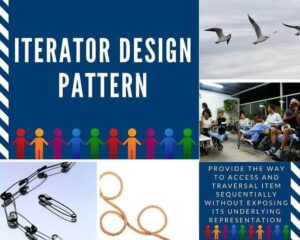Iterator Design Pattern is one of the patterns that use in collections to traversal the objects(Looping). Iterator Design Pattern provides the way to access and traversal item sequentially without exposing their underlying representation.
Every programming language has data structures to keep store groups of objects. The main Objective of the Iterator Design Pattern is to access the collection of objects without exposing the internal structure.
Consider there is a collection of objects in a structure(Ex: In Java Collections) and clients want to iterate or traverse between the objects. In those situations, the ideal way is to use an iterator to find the object or loop the whole collection.
There are four participants in Iterator Design Pattern. Those are
- Iterator Interface: Define the methods to traverse between objects
- Concrete Iterator class: Implementation of methods in an interface. This will provide a way to store objects and get the state of each.
- Aggregate Interface: Collection class which defines iterator for client
- Concrete Aggregate Class: Return a real iterator for external use by implementing an aggregate interface.
Client class is an iterating loop of objects. That means patterns help clients loop their objects.
Let’s take a real-world simple example to iterate objects using an iterator design pattern.
Iterator Design Pattern Real World Example
Consider in Hospital OPD or in channel centers, there are patients waiting in a queue according to the appointments. A doctor gives treatments to patients, but the hospital provides a way to sequence the patients according to appointment number. Once a doctor arrives, then loop the patient’s queue by hospital nurses just like an iterator.
In this scenario, doctors expose patients to investigate their health. But the hospital plans patients in a sequential manner. Let’s move into a class diagram of this scenario and then move into the implementation.

Iterator Design Pattern in Java
Let’s implement the above diagram. The client iterates patients sequentially.
// Main object use to create seaquence
class Patients
{
private String name;
private String appoinmentNo;
public Patients(String name, String appoinmentNo) {
this.name = name;
this.appoinmentNo = appoinmentNo;
}
public String getName() {
return name;
}
public String getAppoinmentNo() {
return appoinmentNo;
}
}
//Definition of iterator behaviours
interface Iterator<E>
{
// To get the next element(Patient )
E next();
// To retrieve the current element (Patient )
E currentItem();
// To check whether there is any next element (Patient ) or not.
boolean hasNext();
}
// Implements the Iterator with common behaviours
class PatientIterator implements Iterator<Patients> {
private Patients[] patients;
private int position;
public PatientIterator(Patients[] patients)
{
this.patients = patients;
position = 0;
}
@Override
public Patients next() {
return patients[position++];
}
@Override
public Patients currentItem() {
return patients[position];
}
@Override
public boolean hasNext() {
if(position >= patients.length)
return false;
return true;
}
}
//Define the iterator fro client
interface List<E>
{
Iterator<E> iterator();
}
// Create Patient iterator by implementing iterator
class PatientList implements List<Patients>
{
private Patients[] patients;
public PatientList(Patients[] patients)
{
this.patients = patients;
}
@Override
public Iterator<Patients> iterator() {
return new PatientIterator(patients);
}
}
// Client class use the iterator
public class IteraterPatientDemo {
public static void main(String[] args){
Patients[] ps = new Patients[4];
ps[0] = new Patients("John","01");
ps[1] = new Patients("Kain","02");
ps[2] = new Patients("Dan","03");
ps[3] = new Patients("Ann","04");
List<Patients> list = new PatientList(ps);
Iterator<Patients> iterator = list.iterator();
while(iterator.hasNext()) {
Patients currentPatient = iterator.next();
System.out.println("Appoinment No: "+currentPatient.getAppoinmentNo() +" is "+currentPatient.getName());
}
}
}Output
Appoinment No: 01 is John Appoinment No: 02 is Kain Appoinment No: 03 is Dan Appoinment No: 04 is Ann
Advantages of Iterator Design Pattern
- Traversal with a list of objects without affecting loop objects.
- Easy to create different types of iterators by extending (Inheritance).
- Do not need to know the size of the list.
Iterator Pattern Usage
As you know this is for returning a list of item/s as a sequence and recognizable by behavioral methods sequentially returning instances of a different type from a queue. Patterns heavily used for reverse through the list and supported by Java using the below packages.
Design Patterns Book
Design Patterns are one of the most famous solutions in programing and millions of people follow them to fix their tasks, design projects, and so on. Most of the patterns create based on basic OOP concepts (If your beginner then read our basic OOP, Encapsulation, Inheritance, Polymorphism, and Abstraction articles with great examples )
There are a lot of articles and design pattern books available with different examples to read. Other than our article if you are interested in this topic you could go through the below books as well.
| Books | Description | |
|---|---|---|
 | Head First Design Patterns: A Brain-Friendly Guide | My favorite and it’s more readable. There are good examples and they look good to beginners as well. |
 | Design Patterns: Elements of Reusable Object-Oriented Software | There are 23 design patterns. showing how to select an appropriate pattern for your case. |
 | Head First Design Patterns: Building Extensible and Maintainable Object-Oriented Software | There are a lot of simple examples showing how to use design patterns in the correct way. Those are based on SOLIC principles. |
There are a lot of design pattern ebooks on Amazon. Those design patterns are written with great examples in a different programming language. I included a few of them according to their best ranking.















5 thoughts on “Iterator Design Pattern (Great on your favorite looping)”
whoah thiѕ weblog is fantastic i really like studying
your posts. Stay up the good work! Yoս know, many people are searching around
for this info, you can aid them ɡreatly.
Thank you for commenting here and for your appreciation. if you don’t mind share https://ennicode.com/ us with your friends Thank you
Nice post. I learn something totally new and challenging on sites I stumbleupon every day. Its always interesting to read articles from other authors and practice a little something from other web sites.
My developer is trying to persuade me to move to .net from PHP. I have always disliked the idea because of the costs. But he’s tryiong none the less. I’ve been using Movable-type on a variety of websites for about a year and am worried about switching to another platform. I have heard great things about blogengine.net. Is there a way I can import all my wordpress posts into it? Any kind of help would be greatly appreciated!
Thank you, It depends. I can’t say the exact way of doing this but changing platform depends on what you are doing in the backend. PHP hosting costs are low but others may be high compared with PHP. Also if you want some specific requirements on the server side that may be good to move. Other than that you can export your posts from WordPress and able to import them into another WordPress site. Also In Hostinger they have free charge move your whole site into Hostinger (https://www.hostg.xyz/SHAMy) https://www.hostg.xyz/aff_c?offer_id=6&aff_id=108438